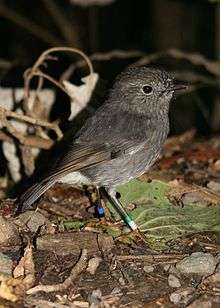Petroica
Petroica is a genus of Australasian robins, named for their red and pink markings. They are not closely related to the European robins nor the American robins.
| Petroica | |
|---|---|
 | |
| North Island robin (Petroica longipes) | |
| Scientific classification | |
| Kingdom: | Animalia |
| Phylum: | Chordata |
| Class: | Aves |
| Order: | Passeriformes |
| Family: | Petroicidae |
| Genus: | Petroica Swainson, 1829 |
| Species | |
|
14; see text | |
The genus was introduced by the English naturalist, William John Swainson, in 1829, with the Norfolk robin (Petroica multicolor) as the type species.[1][2] The generic name combines the Ancient Greek petro- "rock" with oikos "home".[3]
Many species in Australia have a red breast and are known colloquially as "red robins" as distinct from the "yellow robins" of the genus Eopsaltria.[4]
Species and subspecies
The genus contains the following 14 species:[5]
- Rose robin (Petroica rosea)
- Pink robin (Petroica rodinogaster)
- Snow Mountains robin (Petroica archboldi)
- Mountain robin (Petroica bivittata)
- Flame robin (Petroica phoenicea)
- Solomons robin (Petroica polymorpha)
- Pacific robin (Petroica pusilla)
- Norfolk robin (Petroica multicolor)
- Scarlet robin (Petroica boodang)
- Red-capped robin (Petroica goodenovii)
- Tomtit (Petroica macrocephala)
- Chatham tomtit (Petroica macrocephala chathamensis)
- North Island robin (Petroica longipes)
- South Island robin (Petroica australis)
- Black robin (Petroica traversi)
gollark: > This policy supersedes any applicable federal, national, state, and local laws, regulations and ordinances, policies, international treaties, legal agreements, illegal agreements, or any other agreements, documents, policies or standards that would otherwise apply. If any provision of this policy is found by a court (or other entity) to be unenforceable, it nevertheless remains in force. This organization is not liable and this agreement shall not be construed. We are not responsible for any issue whatsoever at all arising from use of potatOS, potatOS services, anything at all, or otherwise.
gollark: https://osmarks.net/p3.html#4-4 overrides this, however.
gollark: The relevant parts of those are overridden by PotatOS privacy policy clause 4.2.γ, however.
gollark: That only works for certain HTTP headers, not all of them.
gollark: Oh, we had to disable that in most space-time because of people duplicating apioids.
References
- Swainson, William John (1829). Zoological illustrations, or, Original figures and descriptions of new, rare, or interesting animals. Series 2. Volume 1. London: Baldwin, Cradock. Plate 36 text.
- Mayr, Ernst; Cottrell, G. William, eds. (1986). Check-list of Birds of the World. Volume 11. Cambridge, Massachusetts: Museum of Comparative Zoology. p. 562.
- Jobling, J.A. (2019). del Hoyo, J.; Elliott, A.; Sargatal, J.; Christie, D.A.; de Juana, E. (eds.). "Petroica". Handbook of the Birds of the World Alive: Key to Scientific Names in Ornithology. Lynx Edicions. Retrieved 17 June 2019.
- Dowling DK (2003). "Breeding biology of the red-capped robin". Australian Journal of Zoology. CSIRO Publishing. 51 (6): 533–549. doi:10.1071/ZO03028. Retrieved 2007-06-07.
- Gill, Frank; Donsker, David, eds. (2019). "Australasian robins, rockfowl, rockjumpers, Rail-babbler". World Bird List Version 9.2. International Ornithologists' Union. Retrieved 17 June 2019.
- Del Hoyo, J.; Elliot, A. & Christie D. (editors). (2006). Handbook of the Birds of the World. Volume 12: Picathartes to Tits and Chickadees. Lynx Edicions. ISBN 978-84-96553-42-2
Further reading
- Kearns, A.M.; Malloy, J.F.; Gobbert, M.K.; Thierry, A; Joseph, L.; Driskell, A.C.; Omland, K.E. (2019). "Nuclear introns help unravel the diversification history of the Australo-Pacific Petroica robins". Molecular Phylogenetics and Evolution. 131: 48–54. doi:10.1016/j.ympev.2018.10.024.
This article is issued from Wikipedia. The text is licensed under Creative Commons - Attribution - Sharealike. Additional terms may apply for the media files.